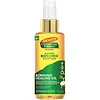What's inside
What's inside
 Key Ingredients
Key Ingredients

No key ingredients
 Benefits
Benefits

 Concerns
Concerns

 Ingredients Side-by-side
Ingredients Side-by-side

Canola Oil
EmollientHelianthus Annuus Seed Oil
EmollientCocos Nucifera Oil
MaskingC12-15 Alkyl Benzoate
AntimicrobialSqualane
EmollientArginine
MaskingBiotin
AntiseborrhoeicCocoyl Hydrolyzed Collagen
CleansingHydrolyzed Vegetable Protein
Skin ConditioningTocopherol
AntioxidantTocopheryl Acetate
AntioxidantCeramide NP
Skin ConditioningArgania Spinosa Kernel Oil
EmollientSimmondsia Chinensis Seed Oil
EmollientButyrospermum Parkii Oil
EmollientMacadamia Ternifolia Seed Oil
EmollientPassiflora Edulis Seed Oil
EmollientPersea Gratissima Oil
Skin ConditioningSclerocarya Birrea Seed Oil
HumectantSesamum Indicum Seed Oil
EmollientVitis Vinifera Seed Oil
EmollientAzadirachta Indica Seed Oil
Skin ConditioningGardenia Taitensis Flower Extract
Skin ConditioningZea Mays Oil
EmulsifyingIsopropyl Myristate
EmollientSodium Benzoate
MaskingWater
Skin ConditioningCI 40800
Cosmetic ColorantParfum
MaskingCoumarin
PerfumingBenzyl Benzoate
AntimicrobialBenzyl Alcohol
PerfumingCanola Oil, Helianthus Annuus Seed Oil, Cocos Nucifera Oil, C12-15 Alkyl Benzoate, Squalane, Arginine, Biotin, Cocoyl Hydrolyzed Collagen, Hydrolyzed Vegetable Protein, Tocopherol, Tocopheryl Acetate, Ceramide NP, Argania Spinosa Kernel Oil, Simmondsia Chinensis Seed Oil, Butyrospermum Parkii Oil, Macadamia Ternifolia Seed Oil, Passiflora Edulis Seed Oil, Persea Gratissima Oil, Sclerocarya Birrea Seed Oil, Sesamum Indicum Seed Oil, Vitis Vinifera Seed Oil, Azadirachta Indica Seed Oil, Gardenia Taitensis Flower Extract, Zea Mays Oil, Isopropyl Myristate, Sodium Benzoate, Water, CI 40800, Parfum, Coumarin, Benzyl Benzoate, Benzyl Alcohol
 Reviews
Reviews

Ingredients Explained
These ingredients are found in both products.
Ingredients higher up in an ingredient list are typically present in a larger amount.
C12-15 Alkyl Benzoate is made up of Benzoic Acid and long chain alcohols. It has a low molecular weight.
C12-15 Alkyl Benzoate is an emollient and texture enhancer. Due to its solubility, it is often used in sunscreens to help evenly distribute active ingredients.
As an emollient, C12-15 Alkyl Benzoate helps soften and hydrate your skin. Emollients create a film on your skin that traps moisture within.
This ingredient has been reported to cause eye irritation.
Learn more about C12-15 Alkyl BenzoateCocos Nucifera Oil is obtained from the kernels of the coconut fruit. In other words, this is coconut oil.
Coconut Oil is rich in fatty acids with lauric acid making up the majority of these. It also contains linoleic acid. Due to this high fatty acid content, coconut oil helps trap moisture and soften skin.
Despite being antibacterial, coconut oil may not be great for acne-prone skin. It is comedogenic and may clog pores. This ingredient may not be safe for malassezia or fungal acne.
Note: Coconut Oil should not replace your sunscreen for UV protection. Studies show it only blocks about 20% of UV.
This oil is non-volatile and has a light scent.
The term 'fragrance' is not regulated in many countries. In many cases, it is up to the brand to define this term. For instance, many brands choose to label themselves as "fragrance-free" because they are not using synthetic fragrances. However, their products may still contain ingredients such as essential oils that are considered a fragrance.
Learn more about Cocos Nucifera OilParfum is a catch-all term for an ingredient or more that is used to give a scent to products.
Also called "fragrance", this ingredient can be a blend of hundreds of chemicals or plant oils. This means every product with "fragrance" or "parfum" in the ingredients list is a different mixture.
For instance, Habanolide is a proprietary trade name for a specific aroma chemical. When used as a fragrance ingredient in cosmetics, most aroma chemicals fall under the broad labeling category of “FRAGRANCE” or “PARFUM” according to EU and US regulations.
The term 'parfum' or 'fragrance' is not regulated in many countries. In many cases, it is up to the brand to define this term.
For instance, many brands choose to label themselves as "fragrance-free" because they are not using synthetic fragrances. However, their products may still contain ingredients such as essential oils that are considered a fragrance by INCI standards.
One example is Calendula flower extract. Calendula is an essential oil that still imparts a scent or 'fragrance'.
Depending on the blend, the ingredients in the mixture can cause allergies and sensitivities on the skin. Some ingredients that are known EU allergens include linalool and citronellol.
Parfum can also be used to mask or cover an unpleasant scent.
The bottom line is: not all fragrances/parfum/ingredients are created equally. If you are worried about fragrances, we recommend taking a closer look at an ingredient. And of course, we always recommend speaking with a professional.
Learn more about ParfumWater. It's the most common cosmetic ingredient of all. You'll usually see it at the top of ingredient lists, meaning that it makes up the largest part of the product.
So why is it so popular? Water most often acts as a solvent - this means that it helps dissolve other ingredients into the formulation.
You'll also recognize water as that liquid we all need to stay alive. If you see this, drink a glass of water. Stay hydrated!
Learn more about Water